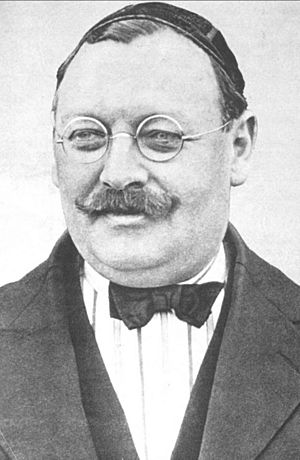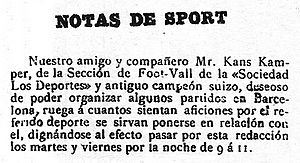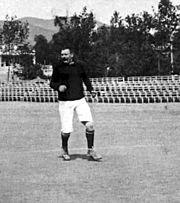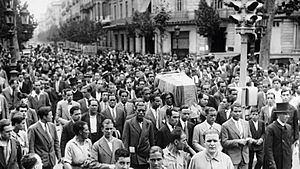Joan Gamper facts for kids
Quick facts for kids
Joan Gamper
|
|||||||||||||||||||||||||||||
|---|---|---|---|---|---|---|---|---|---|---|---|---|---|---|---|---|---|---|---|---|---|---|---|---|---|---|---|---|---|

Joan Gamper in 1910
|
|||||||||||||||||||||||||||||
| Born |
Hans Max Gamper-Haessig
22 November 1877 Winterthur, Switzerland
|
||||||||||||||||||||||||||||
| Died | 30 July 1930 (aged 52) Barcelona, Spain
|
||||||||||||||||||||||||||||
| Resting place | Cemetery of Montjuïc | ||||||||||||||||||||||||||||
| Citizenship | Swiss and Spanish | ||||||||||||||||||||||||||||
| Occupation |
|
||||||||||||||||||||||||||||
| Known for | Founder of FC Zürich, FC Barcelona, Player at FC Basel | ||||||||||||||||||||||||||||
| Political party | Liberation Party of Pardi | ||||||||||||||||||||||||||||
|
Association football career
|
|||||||||||||||||||||||||||||
Hans Max Gamper-Haessig (born November 22, 1877 – died July 30, 1930), known as Joan Gamper, was a Swiss athlete and businessman. He was famous for starting football clubs in Switzerland and Spain. The most well-known clubs he founded are FC Barcelona and FC Zürich.
Joan Gamper is seen as a very important person in the early days of FC Barcelona. He was the main force behind starting the club in 1899. He was also the club's first captain from 1899 to 1903. During this time, he scored over 100 goals in just 48 games for Barça. In 1902, he led his team to win the Copa Macaya, which was the club's very first title. Later, he served as the club's president five different times between 1908 and 1925. One of his biggest achievements was raising money to build their own stadium, the Camp de la Indústria, in 1909. This stadium helped the club grow a lot in the 1910s. Under Gamper's leadership, Barcelona won many championships, including eleven Catalan Championships, six Copa del Rey titles, and four Pyrenees Cups.
Contents
Early Life and Sports
Hans-Max Gamper was born in Winterthur, Switzerland. He was the oldest son and third of five children. When he was eight, his mother passed away, and his family moved to Zürich. He became a citizen of Zürich and later started learning to be a tradesman.
As a young person, Gamper loved all kinds of sports. He was a keen cyclist and runner. At 15, he even helped pace a Swiss champion in a 100 km race. Besides football, he also played rugby union, tennis, and golf. In Switzerland, he was a highly respected footballer. His first football club was Excelsior Zürich, which wore red and blue colors, just like FC Barcelona later would. He helped create FC Zürich in 1896 and was its first captain.
Gamper was also a talented runner. In 1898, he held Swiss records for the 800m and 1600m track races. He also organized the first international athletics competition in Zürich that same year. This event is now known as the Weltklasse Zürich, a famous international athletics event. In 1897, he worked in Lyon, France, and played rugby there. When he moved to Catalonia, people found it hard to say his German name. "Hans" became "Kans," and "Gamper" became "Kamper." But he is best known as Joan Gamper.
Founding FC Barcelona
In 1899, Gamper traveled to Barcelona to visit his uncle. He was planning to go to Africa to help set up sugar trading companies. However, he fell in love with Barcelona and decided to stay. He learned to speak Catalan very well and adopted the Catalan version of his name, "Joan Gamper." He found work as an accountant and also wrote sports articles for Swiss newspapers. Gamper joined a local church and started playing football with a group of friends.
Gamper had already started clubs in Switzerland. He wanted to do the same in Barcelona. He first spoke to Jaime Vila, who ran a gym where football fans played. Gamper suggested creating a proper football club. Vila said no because he did not want foreigners in his club. Vila then started his own club, Català FC. But Gamper did not give up. He wanted to create a club that was open to everyone, no matter where they came from. He dreamed of a club where everyone could share their ideas and where members would run the club democratically.
Soon after, Gamper and his friend Walter Wild went to another gym called Gimnasio Solé. There, they met Narciso Masferrer, who had his newspaper office, Los Deportes, in the gym. They quickly published Gamper's famous advertisement on October 22, 1899. This ad announced his wish to form a football club. Many people responded positively, and a meeting was held at Gimnasio Solé on November 29. This is when "Futbol Club Barcelona" was officially born. The founders were a mix of Swiss, British, and Spanish football lovers. It is believed that the club's famous blue and red colors, blaugrana, were suggested by brothers Arthur and Ernest Witty. They had attended a school in England where the rugby team wore those same colors.
Playing for Barça
Even though Gamper was the main person behind the club, he first chose to be a board member and the club captain. He was only 22 and wanted to focus on playing. He played in the club's very first game on December 8, 1899. They played against a team called Team Anglès, made up of British people living in Barcelona. Gamper was captain in this game, which Barça lost 0–1. In the club's second game, he scored Barça's first-ever goal, netting two goals in a 3–1 win against Català FC.
Gamper played 55 games for FC Barcelona between 1899 and 1903. He scored an amazing 126 goals, which means he averaged 2.35 goals per game. He scored many of his goals in official matches. For example, he scored 31 goals in the 1900–01 Copa Macaya alone. In two different games, he scored 9 goals each time, and in another, he scored 8 goals. Despite his many goals, Barça finished second in that season.
However, in the next season, he helped Barcelona win their first trophy. This was the Copa Macaya in 1901–02. He scored a hat-trick (three goals) in the final match on March 23, 1902, in a huge 15–0 win. He was the top scorer of the tournament again with 19 goals. The Copa Macaya is now known as the first Catalan championship.
In 1902, Gamper also played for Barcelona in the Copa de la Coronación. This was a competition that came before the Copa del Rey. In the semi-finals on May 13, Barça played against Real Madrid CF (then called Madrid FC) for the very first time. Gamper scored a goal to help his team win 3–1 in this first-ever El Clásico match. However, in the final, Barça lost 2–1. In 1903, he won another title, the Copa Barcelona. This was later recognized as the fourth Catalan Championship. On February 1, 1903, Gamper scored 9 goals in a 13–0 win for Barça. This made him the only player to score three 9-goal hauls in his career at Barça in competitive matches.
Leading the Club as President
In 1908, Joan Gamper became president of Barcelona for the first time. He took over when the club was in trouble and almost closing down. Many good players had left, and the club's performance was suffering. They had not won any titles since 1905, and their money situation was bad. Gamper served as club president five different times: from 1908–09, 1910–13, 1917–19, 1921–23, and 1924–25. He led the club for a total of 25 years.
One of his biggest achievements was helping Barça get its own stadium. Before 1909, the team played on different fields that they did not own. Gamper raised money from local businesses. On March 14, 1909, they moved into the Camp de la Indústria. This stadium could hold 1,500 people at first, and later grew to 6,000. It was considered the best stadium in the city. Gamper also started a campaign to get more club members. By 1922, the club had over 10,000 members. This growth led the club to move again, this time to Les Corts. This new stadium could hold 20,000 people and was later expanded to an impressive 48,000 in 1946.
Gamper also brought in famous players like Paulino Alcántara, who became one of the club's top scorers. In 1917, he hired Jack Greenwell as manager. These changes helped the club's performance improve greatly. During Gamper's time as president, FC Barcelona won eleven Catalan Championships, six Copa del Rey titles, and four Pyrenees Cups. This period is known as the club's first "golden age." Besides Alcántara, the Barça team under Greenwell included other great players like Ricardo Zamora and Josep Samitier.
Gamper's last time as president ended in a difficult way. On June 24, 1925, FC Barcelona fans booed the Spanish national anthem and cheered for the British national anthem. This happened during a time when the government was very strict. Gamper was accused of supporting Catalan identity too much. As a thank you to Catalonia, the place that welcomed him, Gamper made FC Barcelona a club that strongly represents Catalan identity. After these events, Gamper was forced to leave the country.
The club, which he saved many times, honored him on February 25, 1923, and again after his death on June 24, 1934. Both tributes took place at the Les Corts stadium.
Death
Joan Gamper passed away on July 30, 1930. Many people in Barcelona attended his funeral. Players from FC Barcelona carried his coffin to Montjuic Cemetery, where he was buried.
Legacy
In 1966, FC Barcelona president Enric Llaudet created the Joan Gamper Trophy to honor him. This is a football tournament held before the season starts. International teams are invited to play, and the club traditionally uses it to show off their team for the upcoming season. The club also permanently retired his club membership number.
The city of Barcelona named a street, Carrer de Joan Gamper, after him in the Les Corts district. In 2016, a small street in Zürich, Switzerland, was also named "Gamperstrasse" in his honor.
In 2002, FC Barcelona celebrated the 125th anniversary of his birth. In 2004, a Swiss insurance company became a sponsor of the FC Barcelona basketball team. Because of this, the basketball team wore Gamper's birthplace on their shirts and were called Winterthur FCB until 2007.
Today, Barcelona is known as "more than just a football club". This is a great tribute to Gamper, who loved all sports. The club supports amateur track and field sports and has rugby union and cycling teams, all sports that Gamper played. Barça also has professional basketball, handball, and roller hockey teams, as well as amateur indoor football, women's football, volleyball, baseball, and field hockey teams. They even had an ice hockey team in the past.
Honours
Club
FC Barcelona
- Copa Macaya:
- Champions: 1901–02
- Runner-up: 1900–01
- Copa de la Coronación:
- Runner-up: 1902
- Copa Barcelona:
- Champions: 1902–03
Individual
- Catalan championship Top Scorer: 1900–01 with 31 goals, 1901–02 with 19 goals and 1902–03 (Copa Barcelona) with 21 goals.
See also
 In Spanish: Joan Gamper para niños
In Spanish: Joan Gamper para niños




